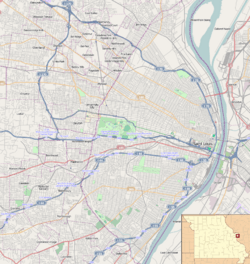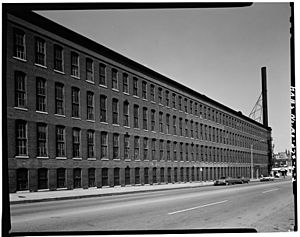Brown Shoe Company's Homes-Take Factory facts for kids
Quick facts for kids |
|
|
Brown Shoe Company's Homes-Take Factory
|
|

Brown Shoe Company Factory (1904-1930s) and International Hat Company Warehouse (1954-1976). Since 1980, the building operates as a senior and disabled living facility.
|
|
| Location | 1201 Russell Boulevard St. Louis, Missouri |
|---|---|
| Built | 1904 |
| Architect | Albert B. Groves |
| NRHP reference No. | 80004503 |
| Designated NRHP | October 20, 1980 |
The Brown Shoe Company's Homes-Take Factory, also known as the International Hat Company Warehouse, is a historic building in St. Louis, Missouri. It is located in the Soulard neighborhood. Built in 1904, this building was first a factory for the Brown Shoe Company. A famous architect named Albert B. Groves designed it.
Later, in 1954, the building became a warehouse for the International Hat Company. This factory shows how good Groves was at designing buildings that were efficient and safe for workers. It also represents how St. Louis became a major manufacturing city in the early 1900s. The Brown Shoe Company helped St. Louis become known for making shoes.
History of the Building
The Homes-Take factory was built in 1904. Albert B. Groves, a well-known architect from St. Louis, designed it. The Brown Shoe Company paid $66,000 to build it. That would be more than $1.7 million today! Groves designed many buildings in St. Louis, including churches, homes, and other factories. He designed eleven factories just for the Brown Shoe Company. The Homes-Take factory started by making women's dress shoes that were not too expensive.
The factory stopped working during the Great Depression. In 1954, the International Hat Company bought the building. They changed it from a factory into a warehouse. Another company, the Mexican Hat factory, bought a different part of the building for offices. The International Hat warehouse closed in 1976.
Later that year, the building was sold to Junior Achievement of the Mississippi Valley. In 1978, Allen Market Lane Apartments bought it. At that time, the area around the building looked empty and sad.
On October 20, 1980, the building was added to the National Register of Historic Places. This means it is recognized as an important historic site. Since 1980, the building has been an apartment complex. It has 100 apartments for older adults and people with disabilities. The apartments were fully updated in 2005.
Building Design and Features
The Homes-Take factory was designed as a four-story building. It is made of red brick and is very long, about 60 feet wide and 300 feet long. The building takes up about half of a city block.
One special part of its design is the many windows. They are placed close together and are ten feet tall by three-and-a-half feet wide. When the building was renovated, new windows were put in. These new windows look just like the original ones from 1904. Keeping the original look of the windows was important. It helped the building stay on the National Register of Historic Places.





